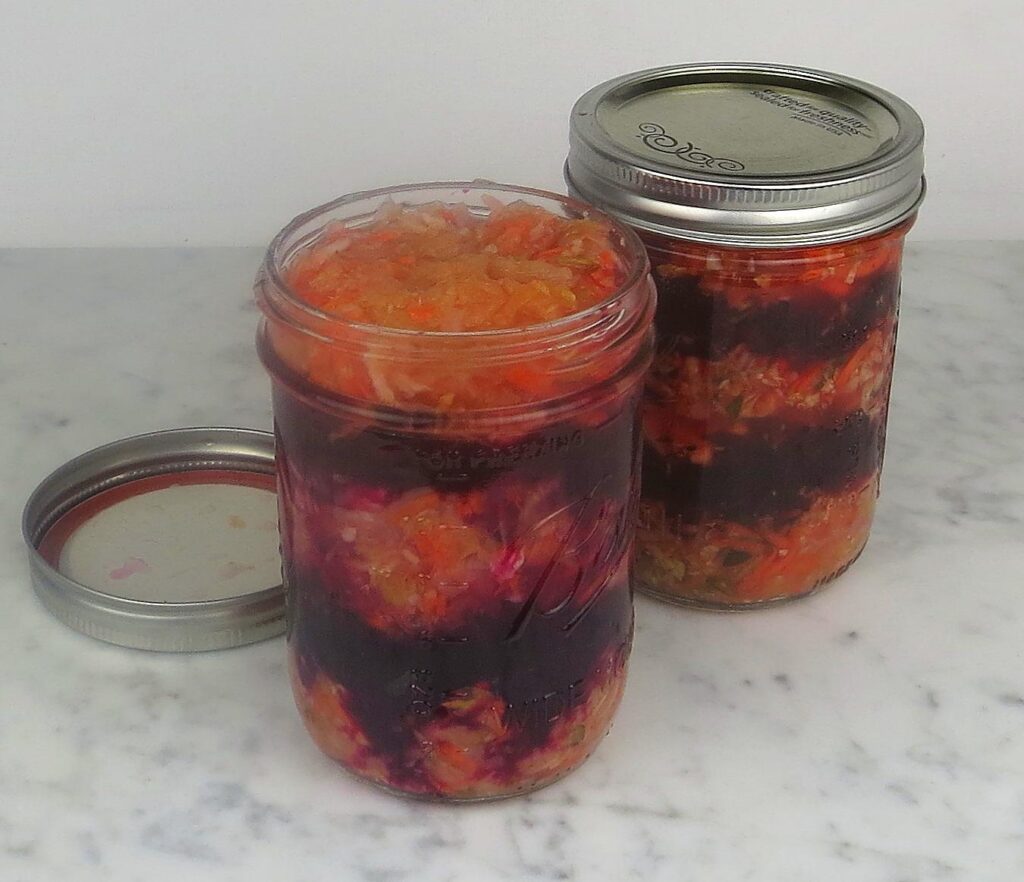This is the easiest and healthiest superfood you can make! Your microbiome is the root of your immune system, your brain function, and therefore your health! Fermented veggies are a natural probiotic that build healthy intestinal flora. And since the immune system relies on plenty of friendly bacteria in the gut, this is central to your health each day. This is a great way to use up leftover raw veggies. Have fun experimenting with different vegetables and low-sugar fruits, creating new combinations. Store in the refrigerator for several months and enjoy as a side dish with every meal. These veggies taste great with Paleo Butternut Squash Soup, or Paleo Shepherd’s Pie. It’s easy to chop or grate with a food processor or blender, but not required. You’ll need two 1-quart glass jars with lids. Makes 1 quart veggies.
Ingredients
- 3 cups vegetables—any vegetable you have! My favorites are cabbage, beet, carrot, daikon, broccoli, cucumber, onion, green beans, kale, chard, zucchini, wild greens, ginger, cilantro, parsley (stems and all), watercress, garlic, ginger, black pepper, soaked seaweed, Granny Smith apple
- 1/2 teaspoon unprocessed salt (optional)
- 1 to 2 cups filtered water
Instructions
- Shred or chop your veggies: Use a food processor (grater or S-blade), a super-blender, or grate and chop them by hand. It doesn’t matter how large they are. Small particles will ferment a bit faster. Stir in the salt, if using.
- Pack the veggies tightly into a quart jar (like a Mason jar). Press them down tight to remove any air pockets. I use a drinking glass as a press.
- Add water so it is 1 inch higher than the veggies. Some people like to cover them with a big cabbage leaf or a slice of cabbage rind. The idea is to weigh them down to keep the veggies under the surface of the liquid. Leave an inch of empty space above the water. Some people like to add a few teaspoons of liquid from another batch of fermented veggies as a starter—this is optional.
- Screw the lid on the jar tightly and leave in a dark cupboard. Fermentation takes 4 to 10 days depending on the temperature. In the summer 4 to 7 days, wintertime about 2 weeks. The ideal temperature is 68 to 75 °F. If the veggies rise above the water, push them back down to keep them submerged. To check if it’s ready, taste it with a clean spoon. When finished, have a big serving and store in the refrigerator. They’ll keep for 6 months or more.
- Tip: Yes, it can happen, rarely, that unfriendly bacteria gets in. You’ll know immediately, as the veggies will be brownish, slimy, and inedible.
“Your diet is like a bank account. Good food choices are good investments.” Bethenny Frankel






4 Replies to "Fermented Veggies 101"
Guthrie Miller December 16, 2022 (9:53 am)
How about adding a little yogurt liquid to seed some good bacteria?
Jane Barthelemy December 16, 2022 (4:20 pm)
Hello Guthrie, Thanks for your comment. WOW! I never thought of that. Why not? Yogurt liquid sounds like a brilliant and fertile idea. I’ll try it! thanks again, Jane
Nat December 6, 2023 (2:27 pm)
Hello, do you mean whey? I got some though is froze, would it work if I defrost it
Jane Barthelemy April 13, 2024 (12:23 am)
Hi Nat, thanks for your question. Regarding the fermented vegetables, I think he meant you can add yogurt, although any living fermented agent such as whey could work. But I doubt it will still be alive after freezing. Anyway, keep it simple and easy, as you don’t need the whey or yogurt. The veggies will ferment by themselves without it and be delicious. Best wishes for your delicious health! Jane